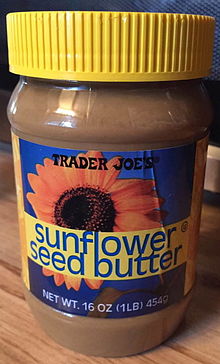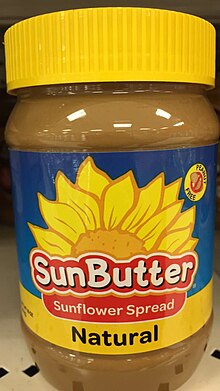Sunflower butter
| Alternative names | Sunflower seed butter, sunbutter |
|---|---|
| Type | Spread |
| Main ingredients | Oil of sunflower seeds |
| |
Sunflower butter, also known as sunflower seed butter, is a food paste made from sunflower seeds.[1] Sunflower butter is commonly used as a substitute for peanut butter when allergies are a concern.
Contents
1 History
2 Health
3 Distribution
4 See also
5 References
History

U.S. commercial versions of sunflower butter were first introduced in the early 1980s as alternatives to peanut butter, particularly for those with nut allergies or peanut allergies. These attempts were unsuccessful, which was attributed to issues with its greenish appearance, "poor texture", and a bitter, under-roasted taste.[2]
Two decades later, in 2000, researchers at the Agricultural Research Service of the Department of Agriculture, working with sunflower seed processor Red River Commodities, developed a formulation that "resembled the texture, flavor, and nutty appearance of commercially available peanut butter", focusing on the degree of roasting and the amounts of sugar, salt, and stabilizer (hydrogenated cottonseed and rapeseed oils).[2] At the same time, Red River Commodities invested in new sunflower seed hybrids and specialized production areas, formed the subsidiary SunGold Foods, Inc., and created a peanut-free and tree-nut-free food processing, packaging, distribution and shipping environment at both companies' locations.[3] The substitute for peanut butter, introduced in 2002, became known as SunButter.[3]
By 2011, SunButter became available at major grocery retailers such as Kroger, SuperValu, Walmart, Target, and Whole Foods.[3]
Several major grocery chains and online retailers produce store-band sunflower butter, including Trader Joe's and Thrive Market.
Health
Sunflower seeds are a good source of protein, fiber, vitamin E, zinc and iron.[4]
They are also rich in alpha-tocopherols, which have been associated with a reduced risk of certain types of cancers.[5]
Due to the prevalence of peanut allergies in the US, many schools there are offering peanut-free menu options or implementing entirely nut-free policies.[6] Sunflower butter can provide an alternative in schools where peanut butter and other nuts have been banned. However, a small number of people with peanut allergies may also be allergic to sunflower seed butter. According to one study,[citation needed] a person with a known peanut allergy suffered an acute reaction to a "nut-free" butter containing sunflower seeds.[7]
Sunflower butter can also be used as a dip for fruit and vegetables, in a sandwich, or in recipes that call for peanut butter;[8] although peanut butter contains higher levels of protein.[9]
Distribution
SunButter, the most widely distributed brand of sunflower butter, is now available in a variety of flavors, and is found in grocery chains and health food stores. It is used in many institutional foodservice programs, including public and private schools and school districts that have become peanut-free and tree-nut-free as part of the Food Allergy and Anaphylaxis Management Act (FAAMA),[10] which calls for voluntary national guidelines to help schools manage students affected by food allergy and anaphylaxis.[3]

See also
- List of spreads
 Food portal
Food portal
References
^ Peabody, Erin (May 17, 2005). "Sunflower Seed Butter Improves As It Spreads Across America". United States Department of Agriculture. Retrieved 2009-01-07..mw-parser-output cite.citationfont-style:inherit.mw-parser-output .citation qquotes:"""""""'""'".mw-parser-output .citation .cs1-lock-free abackground:url("//upload.wikimedia.org/wikipedia/commons/thumb/6/65/Lock-green.svg/9px-Lock-green.svg.png")no-repeat;background-position:right .1em center.mw-parser-output .citation .cs1-lock-limited a,.mw-parser-output .citation .cs1-lock-registration abackground:url("//upload.wikimedia.org/wikipedia/commons/thumb/d/d6/Lock-gray-alt-2.svg/9px-Lock-gray-alt-2.svg.png")no-repeat;background-position:right .1em center.mw-parser-output .citation .cs1-lock-subscription abackground:url("//upload.wikimedia.org/wikipedia/commons/thumb/a/aa/Lock-red-alt-2.svg/9px-Lock-red-alt-2.svg.png")no-repeat;background-position:right .1em center.mw-parser-output .cs1-subscription,.mw-parser-output .cs1-registrationcolor:#555.mw-parser-output .cs1-subscription span,.mw-parser-output .cs1-registration spanborder-bottom:1px dotted;cursor:help.mw-parser-output .cs1-ws-icon abackground:url("//upload.wikimedia.org/wikipedia/commons/thumb/4/4c/Wikisource-logo.svg/12px-Wikisource-logo.svg.png")no-repeat;background-position:right .1em center.mw-parser-output code.cs1-codecolor:inherit;background:inherit;border:inherit;padding:inherit.mw-parser-output .cs1-hidden-errordisplay:none;font-size:100%.mw-parser-output .cs1-visible-errorfont-size:100%.mw-parser-output .cs1-maintdisplay:none;color:#33aa33;margin-left:0.3em.mw-parser-output .cs1-subscription,.mw-parser-output .cs1-registration,.mw-parser-output .cs1-formatfont-size:95%.mw-parser-output .cs1-kern-left,.mw-parser-output .cs1-kern-wl-leftpadding-left:0.2em.mw-parser-output .cs1-kern-right,.mw-parser-output .cs1-kern-wl-rightpadding-right:0.2em
^ ab Lima, Isabel M.; Guraya, Harmeet S. (2005). "Optimization Analysis of Sunflower Butter" (PDF). Journal of Food Science. Institute of Food Technologists. 70 (6): 365–370. doi:10.1111/j.1365-2621.2005.tb11457.x. Retrieved 2011-03-18.
^ abcd "News & Events: SunButter". Agricultural Research Service. USDA. January 4, 2011. Retrieved 2011-03-18.
^ Lima, Isabel; Guraya, Harmeet (2010). "Sunflower Butter" (PDF). USDA. Retrieved 2011-03-02.
^ Thomas, R.G.; Genhardt, S.E. (2012). "Nuts And Seeds As Sources Of Alpha and Gamma Tocopheros" (PDF). USDA. Retrieved 2011-03-02.
^ Groce, Victoria (June 9, 2008). "Why is My Child's School Nut-Free? What food can she bring?". Retrieved 2011-03-03.
^ Hsu, Denise; Katelaris, Constance (2007). "Is "nut-free" sunflower seed butter safer for children with peanut allergy?". The Medical Journal of Australia. Australasian Medical Publishing Company. 187 (9): 542–543. Retrieved 2012-03-01.
^ "USDA Foods Product Information Sheet" (PDF).
^ Thomas, R.G.; Genhardt, S.E. (2012). "Sunflower Seed Butter and Almond Butter as Nutrient-Rich Alternatives to Peanut Butter" (PDF). USDA. Retrieved 2011-03-02.
^ "The Food Allergy & Anaphylaxis Management Act". The Food Allergy & Anaphylaxis Network (FAAN). Retrieved 2012-11-12.
